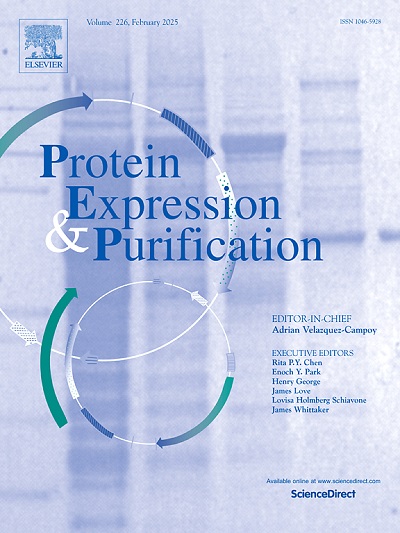Purification, folding, activity analysis and substrate specificity of Pseudomonas diacylglycerol kinase
IF 1.2
4区 生物学
Q4 BIOCHEMICAL RESEARCH METHODS
引用次数: 0
Abstract
The structural and functional investigation of bacterial membrane proteins is crucial to the development of antibiotics. Diacylglycerol kinase (DAGK) from Escherichia coli (E. coli) has been extensively studied as a model membrane protein. However, the DAGK from Pseudomonas aeruginosa (PAO1-DAGK) with a 44 % sequence identity to E. coli-DAGK is not well characterized. To explore the properties of PAO1-DAGK, it was successfully expressed in E. coli and was purified in Decyl-β-D-maltoside (DM) micelles followed with characterizations. Chemical cross-linking studies revealed that PAO1-DAGK in DM micelles could form dimers and trimers. The kinase activity of PAO1-DAGK was determined to be 24.2 ± 2.2 U/mg protein in a mixed-micelle system. The effects of pH and temperature on the activity of PAO1-DAGK were also investigated, respectively. PAO1-DAGK in DM micelles exhibited good stability at pH 6.0–10.0 and below 45 °C. Substrate specificity measurements indicated that PAO1-DAGK demonstrated a clear preference for medium-chain diacylglycerols (DAGs) in the mixed-micelle system, with sn-1,2-Dihexanoylglycerol (DiC6) being the most favored substrate. Molecular docking results demonstrated the interactions between DAGs and PAO1-DAGK.
假单胞菌二酰基甘油激酶的纯化、折叠、活性分析和底物特异性
细菌膜蛋白的结构和功能研究对抗生素的开发至关重要。大肠杆菌二酰基甘油激酶(DAGK)作为一种模式膜蛋白已被广泛研究。然而,铜绿假单胞菌的DAGK (PAO1-DAGK)与大肠杆菌的DAGK序列同源性为44%,尚未得到很好的鉴定。为了探究PAO1-DAGK的性质,我们成功地在大肠杆菌中表达了PAO1-DAGK,并用Decyl-β- d -麦芽糖苷(DM)胶束纯化了PAO1-DAGK,并对其进行了表征。化学交联研究表明,PAO1-DAGK在DM胶束中可以形成二聚体和三聚体。在混合胶束体系中测定PAO1-DAGK的激酶活性为24.2±2.2 U/mg蛋白。研究了pH和温度对PAO1-DAGK活性的影响。DM胶束中的PAO1-DAGK在pH 6.0 ~ 10.0和45℃以下具有良好的稳定性。底物特异性测量表明,PAO1-DAGK在混合胶束体系中对中链二酰基甘油(dag)表现出明显的偏好,其中sn-1,2-二己醇甘油(DiC6)是最受青睐的底物。分子对接结果表明,dag与PAO1-DAGK之间存在相互作用。
本文章由计算机程序翻译,如有差异,请以英文原文为准。
求助全文
约1分钟内获得全文
求助全文
来源期刊

Protein expression and purification
生物-生化研究方法
CiteScore
3.70
自引率
6.20%
发文量
120
审稿时长
32 days
期刊介绍:
Protein Expression and Purification is an international journal providing a forum for the dissemination of new information on protein expression, extraction, purification, characterization, and/or applications using conventional biochemical and/or modern molecular biological approaches and methods, which are of broad interest to the field. The journal does not typically publish repetitive examples of protein expression and purification involving standard, well-established, methods. However, exceptions might include studies on important and/or difficult to express and/or purify proteins and/or studies that include extensive protein characterization, which provide new, previously unpublished information.
 求助内容:
求助内容: 应助结果提醒方式:
应助结果提醒方式:


